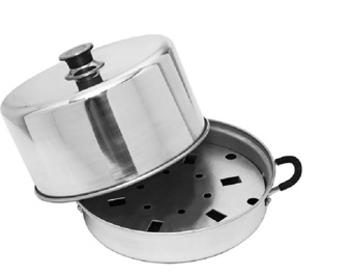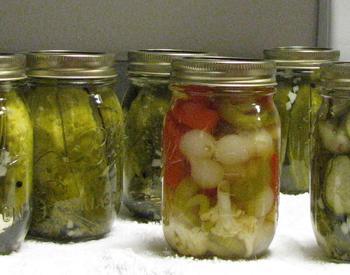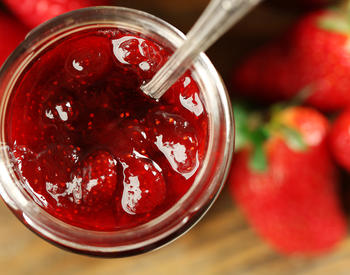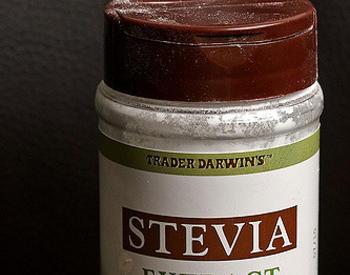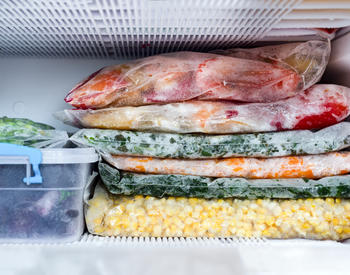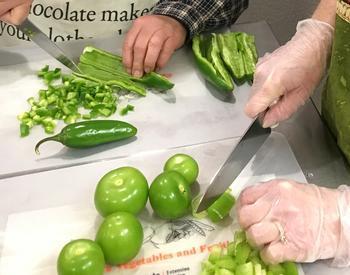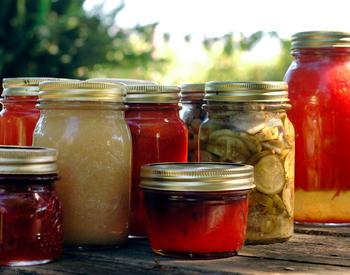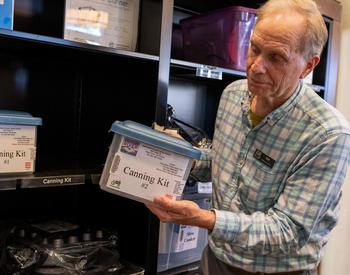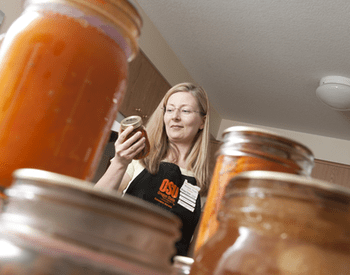Download this publication as a PDF
Oregon beaches, mountains and woods are filled with many wild, native berries. Some of these berries are edible; others should be avoided. Many of these wild berries make delicious jams, jellies and pies.
Types of berries
Some of the more popular ones are listed below with suggestions for how to use them.
There are many berries and fruits growing in the wild. Some are edible and others not, so be sure you know what you are picking.
Watch young children to be sure they show you what they pick and taste. There are many edible plant books available to help you decide whether a fruit, berry or plant is safe to eat.
Red, black and evergreen huckleberries (genus Vaccinium)
These are mainly found in the Cascades and low mountains near the coast. The wild huckleberry is much smaller than the domestic blueberry and very tasty. They make excellent pies, jams, jellies, syrups and are great in muffins, breads and pancakes.
Western huckleberry
This berry is larger and sweeter and has fewer seeds. There are many varieties. They vary from red to almost black in color. These huckleberries can be used in place of blueberries in recipes. The black or blue huckleberries are much more flavorful than the red varieties.
Bog cranberry
This is a small dark-red berry that is found in bogs and sandy areas along the coast. It can be used in sauces and breads.
Oregon grape
The berry from the Oregon state flower, this is picked when dark blue. It is not very tasty eaten raw but makes great jams and jellies. Berries from both the high and low growing varieties are equally good. Oregon grape belongs to the genus berberis.
Wild blackberries (genus Rubus)
These are among the most plentiful wild berries. The small trailing blackberries grow along the coastal mountains. These are very tart and flavorful. They make great pies, jams and jellies. These are the first of the blackberries to ripen.
Next to ripen and the most plentiful are the Himalayan. These berries are medium in size, purple-black when ripe and very mild in taste. They grow along roadways and flat canals in western Oregon and along the coast.
The last blackberry to ripen is the evergreen. They are similar to the Himalayan but milder in flavor and firmer. The bushes are very thorny and the fruit very seedy.
All the blackberries make good juices, jellies, jams, syrups and pies. They can be frozen or canned for later use.
Salal
This is an ornamental shrub that grows wild along the coastal range and in many gardens. The salal berry is a sweet blackberry that ripens in late July or early August. Salal is of the genus Gaultheria. It is often used in pies, jams, jellies and syrups. Salal berries can be mixed with Oregon grape to make jams and jellies.
Blue elderberry (genus Sambucus Glauca)
This is a small shrub ranging in size from 7 to 15 feet. It is found in the wild and is popular in home landscapes. The berries are edible and often used to make wine, syrups, jams and jellies.
Caution
Recent research, testing over 400 samples of elderberries, found the average pH to be 4.92. This falls in the range of a low-acid food, therefore it should not be canned as syrups, juice or berries.
There are special exceptions for canned jams and jellies made with high sugar but the recipes need to be measured by weight not cups in order to be safe. In addition, they should never be made into low-sugar products or products that use honey as a sweetener for canning. Products made from elderberries can be safely refrigerated or frozen for long-term storage.
The red elderberry (Sambucus Callicarpa) should not be eaten. Its clusters of red berries often cause stomach upsets when eaten.
Wild plums (genus Prunus)
These are found in the valley and some southern and eastern Oregon counties. Their color ranges from yellow to a deep reddish-purple. They are especially good for jellies, jams and juices.
Wild currant and gooseberries (genus Ribes)
These are found along streams and other moist areas in the Cascades or along the foothills to the coastal range. These berries make great jellies, jams, syrups, and pies.
Salmonberries and thimbleberries
These are of the same family as the blackberry. They grow on shrubs in the woodlands and are probably the first of the berries to ripen.
Salmonberries range in color from orange to red and look like a raspberry. They are very juicy and lack the rich flavor of raspberries. They are best eaten out of hand.
Thimbleberries are red berries that grow on shrub-like bushes in the woodlands. They are a cap-like berry that is not too flavorful and very seedy. They are also best eaten as found.
Making jam and jelly
Because the processing time is short, use sterilized jars for the following products. To sterilize, place jars right side up on a rack in a boiling water canner. Fill the canner and jars with hot (not boiling) water to 1 inch above the tops of the jars. Boil 10 minutes.
Blackberry, huckleberry and wild plum jam and jelly
The instruction sheets in commercial pectin packages have good recipes for wild blackberries. For huckleberries, use blueberry recipes; for wild plum, use our sour cherry recipes.
Salal and Oregon grape jelly
- 1 quart red salal berries
- 1⁄3 cup Oregon grape berries
- 1¼ cups water
- Lemon juice
- Sugar
Procedure:
- Wash berries and place in large kettle.
- Crush berries with a potato masher.
- Add water and simmer slowly for 5 minutes or until soft.
- Let juice drip through a dampened jelly bag.
- Measure juice; to each 1 cup juice, add 1 cup sugar and 1 teaspoon lemon juice.
- Boil rapidly until jelly sheets from a metal spoon.
- Skim well; pour into hot, sterilized jars. Leave 1⁄4-inch headspace.
- Adjust lids and process half-pint jars 5 minutes in a boiling water canner.
- After processing, take canner off heat. Remove lid. Wait 5 minutes before removing jars.
Salal jelly
- Use equal parts of salal juice and tart apple juice. Bring to a boil and add 1 cup sugar for each cup of juice and let boil until jelly stage.
- Pour into hot, sterilized jars. Leave 1⁄4-inch headspace.
- Adjust lids and process half-pint jars 5 minutes in a boiling water canner.
- After processing, take canner off heat. Remove lid. Wait 5 minutes before removing jars.
Oregon grape jelly
- Select firm ripe Oregon grapes. Wash, leaving on stems.
- Place in large preserving kettle, covering with water. Boil 10 minutes, then mash and boil 5 minutes longer.
- Drain through jelly bag. Measure juice into large preserving kettle and boil 10 minutes.
- Add 3⁄4 as much sugar as juice. Stir until sugar is dissolved. Boil rapidly until it sheets from a spoon.
- Remove from heat, skim at once and pour into hot, sterilized jars.
- Leave 1⁄4-inch headspace. Adjust lids and process 5 minutes in a boiling water canner.
- After processing, take canner off heat. Remove lid. Wait 5 minutes before removing jars.
For additional information on preserving wild berries and fruits, and juice extraction methods, refer to Preserving Berries.
Related Articles
- Preserving Foods: Fruit Juice and Apple Cider
- Low Sugar Jams Jellies/Fruit Spreads
- Fruit Pie Filling
Source: OSU Master Food Preserver Program

